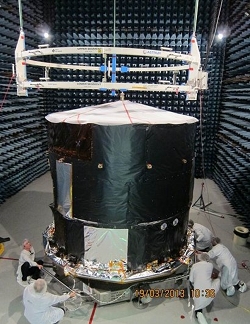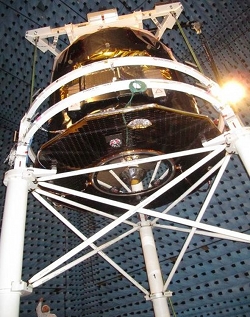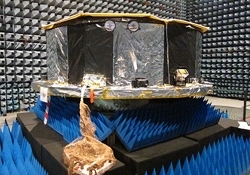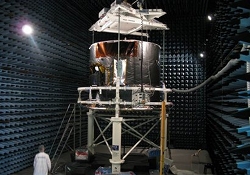#10: Gaia Electromagnetic Compatibility Testing
31 May 2013
The integrated Gaia Flight Model (FM) spacecraft has completed its electromagnetic compatibility test campaigns, which ensure that it will not interfere with systems on the launch vehicle and also confirm that all its subsystems will be able to operate without affecting one another by their radiated emissions or through interference injected into the power supply lines.What is Electromagnetic Compatibility?
Electromagnetic Compatibility (EMC) testing is the determination, amongst other things, of whether the various subsystems of a spacecraft will be able to operate without interfering with one another. For example, subsystems such as the RF equipment that transmits science data to Earth must not cause interference to the sensitive electronics used to process signals from the Focal Plane Array.
Launcher Compatibility Testing
Some of Gaia's subsystems, including the battery and power unit, the central computer and the radio receiver, will have to be operational on the launch pad and during the launch phase of the mission. The launch authority has to be sure that any electromagnetic signals emitted by these systems will not interfere with the operation of the launch vehicle. In particular, Gaia testing has to demonstrate that the Fregat upper stage that will inject Gaia into its L2 transfer orbit, and which is closest to the spacecraft during launch, will not experience electromagnetic interference from its passenger.
Since only Service Module (SVM) systems will be operational during launch and the Payload Module (PLM) will be inactive, launcher compatibility testing was conducted with the SVM alone. The testing was performed at the facilities of Intespace, Toulouse, where the SVM was installed in an anechoic room – a test chamber that ensures that no external electromagnetic signals can reach the device under test. The chamber walls are lined with blocks of RF-absorbent foam, which prevent signals radiated from the spacecraft being reflected back from the walls; this simulates the environment of 'free space' when the spacecraft's antennas are radiating.
Test antennas connected to specialised receiving equipment were used to measure the signal levels emitted by those systems that will be operating during the launch phase, to verify that they meet the requirements of the launch authority. These tests were completed in August 2012.
Autocompatibility Testing
In March this year, the complete Gaia FM spacecraft was transported from the premises of Astrium in Toulouse, where the integration of the PLM and SVM was performed, to Intespace, situated close by, and installed in the anechoic chamber for the autocompatibility test.
Normally when tests are performed on ground, for example to verify the functionality of the spacecraft, the antennas are covered with special test caps so that no radiation is emitted. This is to protect operators working in the direct vicinity of the spacecraft while it is in the cleanroom. Also, it is unusual for all the spacecraft subsystems to be active at the same time during testing, because most often only a part of the spacecraft is being tested at any one time.
The EMC autocompatibility test allows the antennas to radiate without their test caps, to see if and how much their emissions interfere with other spacecraft subsystems. All the units that will be active during nominal operations such as the AOCS sensors and actuators and the payload are switched on.
 |
 |
|
Left: Gaia Flight Model spacecraft being prepared for electromagnetic compatibility testing; right: View from beneath the support pedestal showing the Phased Array Antenna. Credit: Astrium |
|
Although this is a standard test for all spacecraft, there was an extra degree of complexity for Gaia. At the same time as the autocompatibility test was performed, the functionality of the Phased Array Antenna (PAA) was verified. The PAA is a new development and thus needed extensive testing.
The spacecraft was mounted on a pedestal to elevate it above the floor of the test chamber. Only in this way could the signals from the PAA be captured. The pedestal is made of Glass Fibre Reinforced Polymer (GFRP), to minimise its effect on the measurements.
Once the EMC test campaign had been successfully completed, the Gaia FM spacecraft was ready to move on to mechanical testing. These tests include measuring its mass properties, acoustic testing to replicate the noise environment during launch and swept-sine vibration tests.
About Gaia
Gaia will create a three-dimensional map of the Milky Way, in the process revealing information about its composition, formation and evolution. The mission will perform positional measurements for about one billion stars in our Galaxy and Local Group with unprecedented precision, together with radial velocity measurements for the brightest 150 million objects. Gaia is scheduled to launch in 2013 for a nominal five-year mission, with a possible one-year extension.
The spacecraft will operate in a Lissajous orbit around the second Lagrange point of the Sun-Earth system (L2). This location in space offers a very stable thermal environment, very high observing efficiency (since the Sun, Earth and Moon are all behind the instrument field of view) and a low radiation environment. Uninterrupted mapping of the sky will take place during the operational mission phase.
The Prime Contractor for Gaia is Astrium SAS, based in Toulouse, France.






